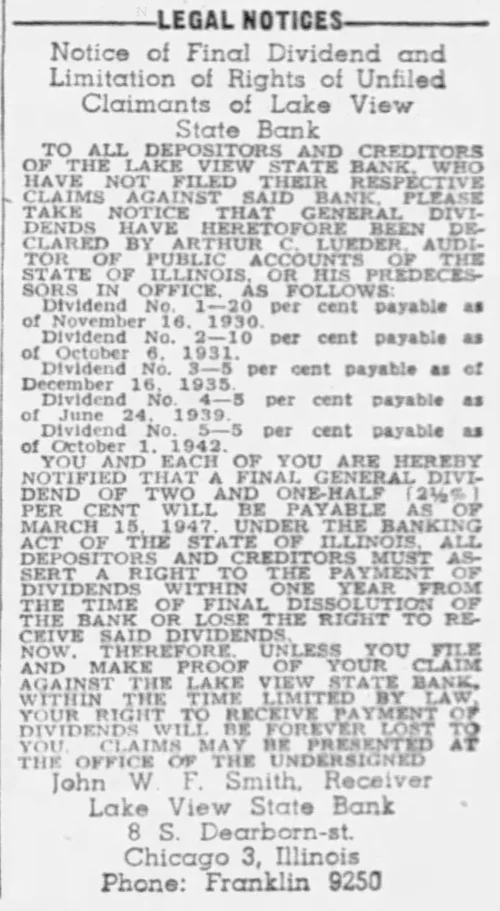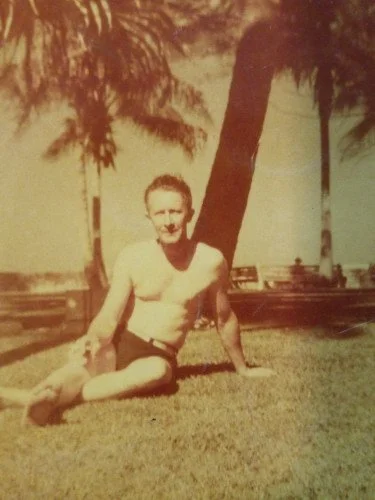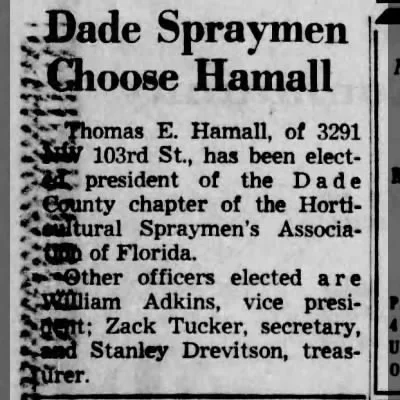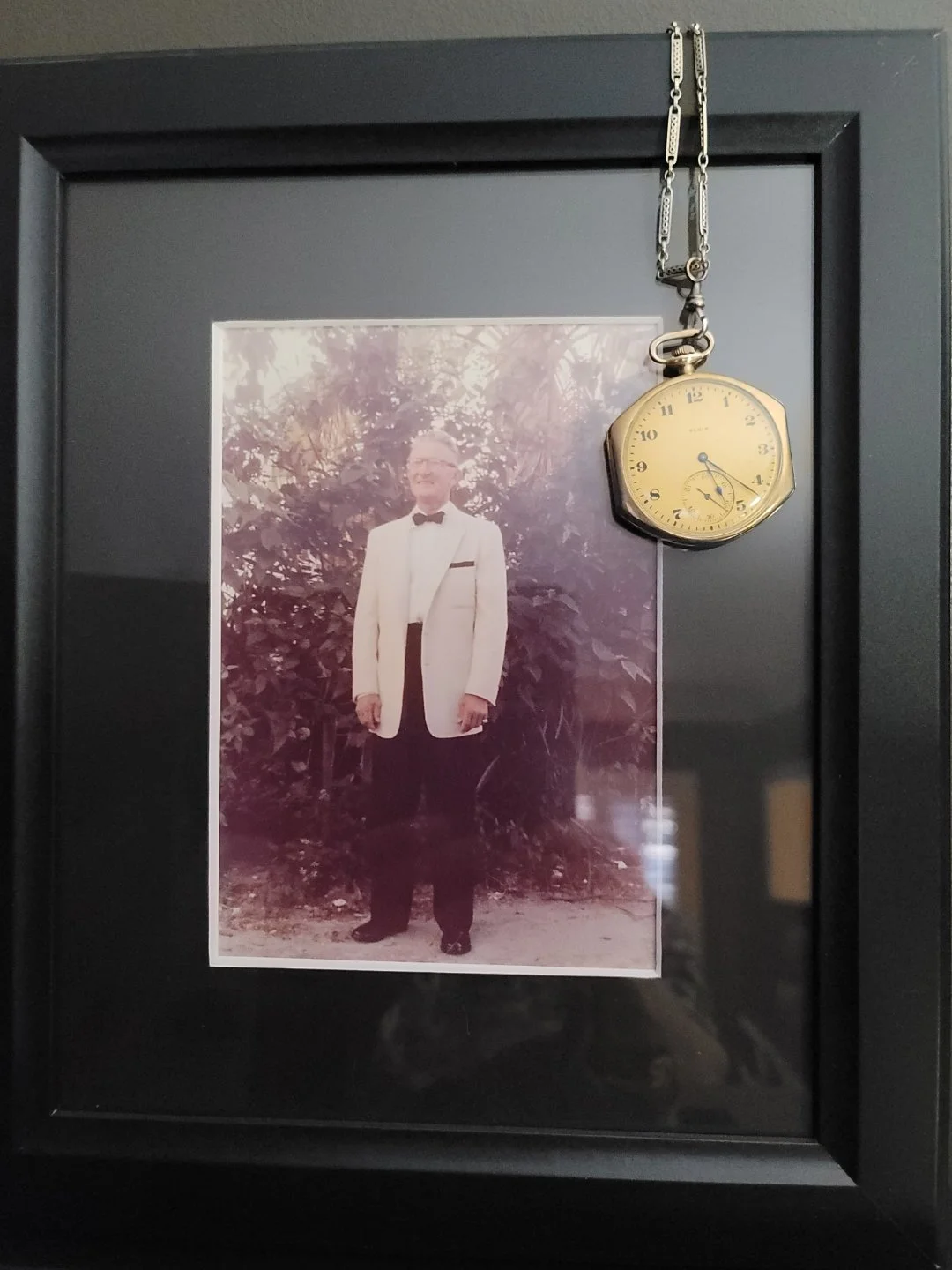The Father Who Tried
Thomas Eugene Hamall’s 23-Year Struggle, His Calling Found, and the Proximity That Career Eventually Separated

Thomas Kenny Hamall's wedding, November 23, 1957. Thomas Eugene Hamall stands at right, having traveled from Miami to attend his son's wedding. The date happened to be Thomas Eugene's 53rd birthday.
The Wedding Photo
November 23, 1957. A young couple stands at the center of their wedding photograph, surrounded by a priest and both sets of parents. On the far right stands Thomas Eugene Hamall, age 53, wearing a suit and boutonniere. He has traveled from Miami to attend his son Thomas Kenny's wedding in Caldwell, New Jersey.
The date is significant not for the reason you might think. November 23 was Thomas Eugene's birthday—his 53rd. Whether the wedding date was chosen deliberately or by coincidence, we don't know. What we do know is this: Thomas Eugene was invited, and he came.
This single photograph contradicts a narrative that would later emerge—that Thomas Eugene Hamall was an absent, estranged father. The evidence tells a different story. It tells the story of a man who struggled for over two decades, who rebuilt his life from devastating losses, who moved to Miami to be in the same city as his son, who was there during his son's young adult years in the early 1950s, and who maintained connection even after his son's career moved him 1,200 miles away.
This is not a story about perfection. It's a story about effort.
The Devastating Beginning (1930-1953)
Thomas Eugene Hamall was born November 23, 1904, in Chicago. He grew up as an only child, raised primarily by his mother Emma Guilbault after his parents' divorce in October 1907. By the 1920s, he had found steady work as a teller at the Lake View State Bank in Chicago.
On June 4, 1930, at age 25, Thomas Eugene married Margaret Katherine Kenny at Our Lady of Lourdes Catholic Church. Four months later, on September 22, 1930, the Lake View State Bank failed.
The timing was devastating. The marriage was just beginning. The Great Depression was beginning. Thomas Eugene's career was ending.
The Lake View State Bank Failure
The collapse of Lake View State Bank was part of the wave of bank failures that defined the early Depression. Thomas Eugene lost not just his job, but his entire career path. Banking jobs vanished. Finding any employment became nearly impossible.
In 1932, with the Depression at its worst, Thomas Eugene and Margaret welcomed their son, Thomas Kenny. This should have been a moment of joy. Instead, it was a moment of economic terror.

Notice of final dividend to Lake View State Bank depositors, 1947. Seventeen years after the bank's failure, the final claims were still being processed. The impact on employees like Thomas Eugene was immediate and catastrophic.
The Lost Years
What happened between 1930 and 1953, we don't fully know. The historical record shows only fragments:
- 1930-1940: Economic struggle through the Depression
- 1930s: Family living together at McVickers Avenue with Emma
- 1940: Still married, living in Chicago
- 1940-1942: Marriage ends in divorce
- ~1942: Margaret and Thomas Kenny relocate to Miami with her parents
- By 1950: Thomas Eugene also in Miami, living with his mother Emma
- Early 1950s: Thomas Kenny living in Miami—father and son in the same city
These were hard years. Years of unemployment, underemployment, instability. Years of watching his marriage collapse. But by the early 1950s, both Thomas Eugene and his adult son were living in Miami, both working, both building lives.
"Twenty-three years passed between the bank failure in 1930 and the first evidence of Thomas Eugene finding professional success in 1953. Twenty-three years."
The Evidence Was Always There

Thomas Eugene and young Thomas Kenny together. Father and son, before the distance.

Thomas Eugene at Miami beach, July 26, 1948. By this time, he was either visiting or already living in Florida.
In the 1930s, Thomas Eugene, Margaret, and baby Thomas Kenny lived together at the house on McVickers Avenue in Chicago with Thomas Eugene's mother Emma. Baby pictures of Thomas Kenny are labeled "house at McVickers"—inside and outside views showing the young family together.
Looking back at those photographs, the landscaping talent is visible. Well-maintained gardens. Thoughtful plantings. An eye for design. The skill was always there. But the Great Depression and its aftermath gave him no opportunity to build it into a career. You can't become a landscape professional when no one can afford to hire you. You can't build a nursery business when you're struggling to survive.
But the talent remained, waiting for circumstances to change.
Miami: Father and Son in the Same City
Around 1942, Margaret Kenny Hamall relocated to Miami with her son Thomas Kenny, then about 10 years old. She moved with her parents, Thomas P and Ellen O'Connor Kenny, who had already settled in southern Florida.
By 1950, Thomas Eugene Hamall was also living in Miami. The 1950 census places him at 289 NE 90th Street with his mother Emma. Meanwhile, Margaret and Thomas Kenny were living with Margaret's parents at 8101 N 1st Street—approximately 10 minutes apart.
But more significantly: in the early 1950s, Thomas Kenny himself was living in Miami.
After serving in the Navy, Thomas Kenny worked for North American Loan and Thrift, and later for the American Cancer Society—all while based in Miami. For a period in the early-to-mid 1950s, father and son were in the same city, both adults, both working, both building their lives.
The Geography of Proximity (Early 1950s)
Thomas Eugene wasn't just near his ex-wife and young son. For a period of years in the early 1950s, he and his adult son Thomas Kenny were both living and working in Miami.
This was opportunity. This was proximity. This was time together as adults, not just as father and young child.
The 1947 DC trip had been when Thomas Kenny was 15. Now, in the early 1950s, he was in his early 20s, a Navy veteran, starting his professional career. Father and son were both in Miami, both making their way.
The Success Years (1953-1967)
In 1953, at age 49, Thomas Eugene Hamall appears in the Miami city directory listed as a "landscaper" at 3291 NW 103rd Street. This is the first documented evidence of him working in the field that would become his calling.
Over the next 14 years, he built something remarkable.

1956: Thomas Eugene quoted as bougainvillea expert in Miami Herald

1958: Bow-Arrow Gardens business listing, Miami News

1963: Thomas E. Hamall as president of Horticultural Spraymen's Association
From Struggle to Respect
By the early 1960s, Thomas Eugene Hamall had achieved something significant. He wasn't just surviving—he was thriving. He owned his own nursery business. He was a recognized expert, quoted in newspapers. He held leadership positions in professional associations. He testified before state legislators on horticultural issues.
The man who lost everything in 1930 had, by age 58, rebuilt his life entirely.

Thomas Eugene in formal wear, likely at an association event. This is a successful professional, respected in his field.

November 1964: Thomas Eugene by his car in Miami. Age 60, three years before his death.
"He struggled for 23 years (1930-1953). He succeeded for 14 years (1953-1967). Then he died."
The Contact Maintained
Throughout this period—the struggling years and the successful ones—Thomas Eugene maintained contact with his son.
1947: The DC Trip
In 1947, when Thomas Kenny was 15 years old, attending St Charles Seminary in Maryland, Thomas Eugene took him on a trip to Washington, DC. Thomas Kenny would later describe this trip as "pivotal"—a significant life event. The trip may have included Thomas Eugene's cousin Emmett Holland, creating a three-generation connection to the Hamall family history.
1957: The Letter
On November 12, 1957—two weeks before his son's wedding—Thomas Eugene sent a lovely heart felt letter and card to his future daughter-in-law in New Jersey. This wasn't an obligation. This was reaching out, trying to connect, extending welcome to the woman who would marry his son.
1957: The Wedding
And then, on November 23, 1957, Thomas Eugene traveled from Miami to attend his son's wedding. He didn't just show up at the church. He stayed for the reception. He was included in the formal family photographs. He wore a boutonniere as an honored guest.
The date happened to be his 53rd birthday. Whether this was intentional or coincidental, we don't know. What we know is that he was there.
What the Wedding Photo Proves
Thomas Eugene was not estranged from his son in 1957.
- He was invited to the wedding
- He traveled 1,200 miles to attend
- He was included in formal family photos
- He was treated as an honored guest (boutonniere)
- He stayed for the entire event
This is not what estrangement looks like. This is what complicated-but-maintained family relationships look like.
When Career Created Distance
In 1957, the American Cancer Society transferred Thomas Kenny to New York. This was a professional opportunity, a career advancement. But it meant leaving Miami—and leaving his father.
On November 23, 1957, Thomas Eugene traveled from Miami to attend his son's wedding in Caldwell, New Jersey. Then Thomas Kenny's career kept moving him: New Jersey, then Omaha, Nebraska, then back to New Jersey. His family grew—five daughters born between 1958 and 1964 as they moved across the country.
Thomas Eugene remained in Miami. Running his nursery business. Serving as association president. Caring for his aging mother Emma, who entered a nursing home sometime after 1962. His son was no longer 10 minutes away. His son was now 1,200+ miles away, moving between states, raising small children, building a career.
The Changing Geography (1950-1967)
Early 1950s: Thomas Eugene in Miami, Thomas Kenny in Miami (same city)
1957: Thomas Kenny transferred to New York
1958: First grandchild born in Newark, NJ
1959-1960: Family in Omaha, Nebraska (two more children born)
1963-1964: Family back in New Jersey (two more children born)
1967: Thomas Eugene dies in Miami
Thomas Eugene didn't create this distance. Thomas Kenny's career did. The American Cancer Society transferred him. His job moved him between states. He was raising five young children while managing a professional career that required geographic mobility.
Thomas Eugene stayed put. He was in Miami if his son needed him, if his grandchildren could visit. But travel with five small children was difficult and expensive. Thomas Eugene was caring for Emma. His own health may have been declining.

Thomas Eugene in his later years in Miami, standing by water and palm trees. Florida had become home—but his son and grandchildren were 1,200 miles away.
The Logistics Reality
Between 1957 and 1967, Thomas Kenny had five children while moving between New York, New Jersey, Nebraska, and back to New Jersey. Thomas Eugene ran a business and cared for his declining mother in Miami. The physical distance was formidable. The logistics were real.
In 1967, Thomas Eugene died at age 62. His mother Emma would outlive him by three years, dying in 1970.
Thomas Kenny's five children—ranging from age 3 to 9 when their grandfather died—never met Thomas Eugene. Not because he was absent, but because geography, career mobility, caregiving, and time ran out.
"They had proximity in the early 1950s. They had the 1947 DC trip. They had the 1957 wedding. Then Thomas Kenny's career moved him across the country, and the distance became insurmountable."
Feeling vs. Fact: Both Can Be True
Later in life, Thomas Kenny would describe feeling "estranged" from his father. This was his lived experience, and it was real.
But the documentary evidence tells a parallel story:
What Thomas Kenny Felt
- Distance from his father
- Estrangement
- Lack of relationship
- His children never knowing their grandfather
This was real. This was valid. This was his experience.
What the Evidence Shows
- Thomas Eugene moved to Miami to be near his son
- Lived 10 minutes away for 17 years
- Took son on "pivotal" DC trip
- Sent letter before son's wedding
- Attended wedding, traveled 1,200 miles
- Geography made ongoing contact difficult
- Caregiving responsibilities compounded barriers
This was also real. This was also valid. This was effort.
These aren't contradictory truths. They're complementary ones.
Thomas Kenny could feel estranged because:
- His parents divorced when he was young
- He lived primarily with his mother and her parents after the divorce
- After 1957, his career moved him across the country while his father stayed in Miami
- Distance and logistics made regular contact difficult
- By the time he had children, geography had separated them by 1,200+ miles
- His father died before his children could know him
- The relationship never developed the sustained closeness he wanted
Thomas Eugene tried because:
- He moved to Miami to be in the same city as his son
- He was there during his son's early adult years in the 1950s
- He created meaningful moments when possible (DC trip, wedding)
- He reached out (letters, attendance, presence)
- He rebuilt his entire life after devastating losses
- He stayed in Miami, available, if his son needed him
The Pocket Watch
There is one more piece of evidence—perhaps the most telling of all.
Thomas Kenny kept his father's pocket watch. Engraved with the initials TEH—Thomas Eugene Hamall—the watch had belonged to his father. After Thomas Eugene's death in 1967, Thomas Kenny held onto it.
At each of his five daughters’ weddings, Thomas Kenny placed that pocket watch in his pocket, fastened it to a gold chain, and wore it.
Every single wedding. All five daughters. His father's watch, with his father's initials, present for each ceremony.
What the Pocket Watch Tells Us
You don't wear your father's watch to your daughters' weddings if the relationship meant nothing.
You don't keep it, maintain it, attach it to a gold chain, and deliberately wear it at your children's most important moments if you feel only estrangement.
You do that because:
- You want your father present, even if he's gone
- You're honoring him at meaningful family moments
- You're creating continuity across generations
- The relationship mattered, even if it was complicated
- You're carrying him with you, literally, in your pocket
This is not what estrangement looks like. This is what love looks like—complicated, bittersweet, but real.
Thomas Kenny could feel estranged from his father. He could wish the relationship had been closer, more present, more consistent. He could carry pain about what wasn't.
And simultaneously, he could honor his father at every one of his daughters' weddings by wearing his watch.
Both are true. Both matter. Both are part of the story.
No Villains, Just Circumstances
Thomas Eugene Hamall was not a perfect father. But he was a father who tried.
He lost his career four months after his marriage. He struggled through the Depression. He lost his marriage. He moved to Miami and was there, present, available, during his son's young adult years in the early 1950s. He spent 23 years rebuilding himself professionally.
And when he finally found his footing—when he finally became successful, respected, professionally accomplished—his son's career moved him across the country. Thomas Eugene stayed in Miami. His son moved to New York, New Jersey, Nebraska, back to New Jersey. The distance wasn't absence—it was logistics, career, family obligations on both sides.
Thomas Eugene had just 14 years (1953-1967) of professional success after 23 years of struggle. His grandchildren never met him. Not because he was absent, but because career mobility, geography, caregiving, and time ran out.
But his son kept his watch. Wore it, with its engraved initials—TEH—to every one of his daughters' weddings. Carried his father with him, literally, in his pocket, to the most important family moments.
That's what this story is about. Not perfection. Not absence. Not estrangement. But effort, and honor, and love that persists even when careers create distance and life becomes complicated.
Thomas Eugene Hamall tried. He was there in the early 1950s. He came to the wedding in 1957. And his son remembered. That's what the evidence shows. That's what this story witnesses.
What We Learn From Thomas Eugene's Story
For Genealogists and Family Historians:
- Examine the full documentary record before accepting family narratives about "absent" parents
- Geographic proximity is itself evidence of effort, even when closeness remains elusive
- Economic devastation (Depression, bank failures, job loss) shapes family structures for decades
- Professional success achieved late in life is still success—and represents resilience
- Multiple perspectives can all be true simultaneously
- Feelings of estrangement are valid even when evidence shows effort
- Look for physical inheritance patterns: What did descendants keep? What did they wear? What did they pass down?
For Families Today:
- If an ancestor seemed "absent," ask: what was the geographic distance? What were the logistics?
- Look for evidence of effort: letters, visits, proximity, attempts to maintain contact
- Economic struggle explains many family separations—it's not always about choice
- Caregiving responsibilities (elderly parents) often limit other relationships
- Your ancestor's feelings AND their parent's efforts can both be real
- Sometimes we run out of time before we run out of reasons to try
- Ask: What items were kept? What was worn? What was treasured? Physical objects tell emotional stories.
At each of his five daughters’ weddings. All five daughters. His father's watch, with his father's initials, present for each ceremony.
The Complete Three Thomas Hamalls Series
This post is part of a comprehensive case study documenting three generations of Thomas Hamalls, one cottage in Riverside, Illinois, and 130 years of family history proven through forensic analysis, legal documents, and oral history verification.
1. The Property War
How Thomas Henry Hamall fought a four-year legal battle to the Illinois Supreme Court to protect the cottage his mother helped him buy.
2. They Were Never Photographed Together
How forensic photographic analysis proved three generations of connections when subjects were captured in separate frames.
3. The Mystery Man
Using forensic ear analysis to identify Emmett John Holland in a 1947 photograph—20 years after he died and his memories were lost forever.
4. Mothers and Sons: A Working-Class Family Pattern
Three generations of mothers living with their sons—not dependence, but economic survival strategy in working-class America.
5. The Father Who Tried
Thomas Eugene Hamall's 23-year effort to maintain connection with his son despite divorce, distance, and the barriers of 1940s America.
6. Three Generations of Shrinking and Expanding
From Kate's six children to near-extinction to explosive survival—how child mortality, small families, and one generation's choice saved the family line.
Explore the Complete Case Study
View the Full BCG-Compliant Case Study →Explore the Complete Case Study
This story is part of the comprehensive Three Thomas Hamalls case study, featuring 22 primary sources, forensic photographic analysis, legal documents, and BCG-compliant methodology across 87 years.
View Complete Case Study →Want to see where it all began? The Three Thomas Hamalls story starts with Owen Hamall—a seven-year mystery spanning three countries. Explore the Owen Hamall case study to see how one census entry led to uncovering four generations of family history.
Does Your Family Have an "Absent Parent" Story?
Documentary evidence can reveal efforts that family narratives obscured. Geographic records, professional achievements, letters, and even inherited objects all tell stories about relationships that distance made difficult but didn't erase.
If your family tree includes stories of absent, estranged, or "difficult" parents, the documentary record may reveal a more complex truth.
Does Your Family Story Need Context?
Family narratives about "absent" parents often hide more complex stories of effort, economic struggle, and geographic barriers. Through archival research and compassionate analysis, we can reconstruct what actually happened—honoring both the feelings and the facts.
Storyline Genealogy specializes in cases where:
- Family narratives conflict with documentary evidence
- Relationships were fractured by divorce, distance, or economic hardship
- Stories were lost between generations
- Multiple perspectives need to be honored
- Physical objects (like pocket watches) suggest connection that oral history denies
Part of the Three Thomas Hamalls Case Study Series
Storyline Genealogy | 2025

